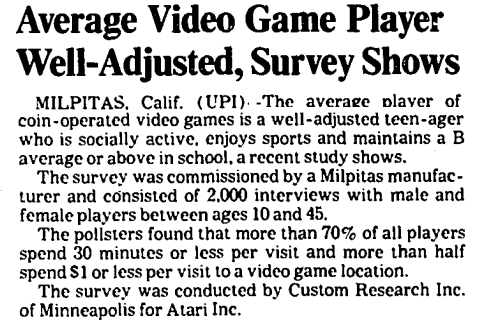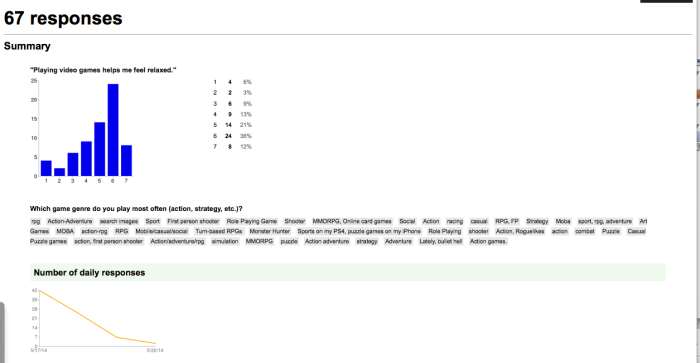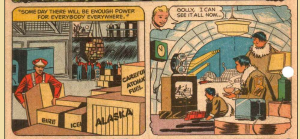PDF of this: Playing Video Games helps me relax. – Google Forms
Uncategorized
Data Visualization of Published Findings on Video Games and Aggression in Children 1995-1999
StandardData Visualization of Published Findings on Video Games and Aggression in Children 1995-1999 (n = 6). That is, only 6 published studies, specifically on the relationship between video games and aggressive behavior (review articles not included), were published in that time frame that I could find (via Web of Science). Subjects are mostly children and young adolescents, with two studies testing undergraduates.
You can see that, compared with the studies between 1984-1995, there is starting to be a little bit of variation with categories of findings.
A Note On Defining Violence in Entertainment for Research
StandardIn James Potter’s 1999 book On Media Violence, he explains that violence is a “primitive concept” in that “we know it when we see it” (63). Instead of using definitions, we use examples.
ex. It’s 100 degrees out, and those kids have nerf water guns! Oh look, she’s shooting her with a beam of water from that rifle. I’m so jealous, that looks like so much fun. <— Violent or not violent?
How to do an online search – 1983
Standard“Frustration, Fun in Learning to Cope With High-Tech Revolution” – Los Angeles Times, Nov 27, 1983
“The computer revolution is affecting thousands of teachers and students in the Los Angeles County as they learn to cope with the new technology. The process can be thrilling, enlightening and inspiring. It can also be frustrating, infuriating and funny. Here are some reports.”
Army Uses Computers to Recruit Nintendo Generation – 1990
Image
Kim Foltz, The New York Times (1923-Current file); Mar 21, 1990; ProQuest Historical Newspapers: The New York Times (1851-2009), pg. D21
Ed Talks To Johnny About The Atom
Standard[deetronic talkin’] Just a note to add- In the post WWII years, comics featuring atomic power, atoms, superheroes and villains changed by atomic power, etc. were popular. It sort of makes this one fascinating, as Edison clearly caught on to what children were paying attention to, as well as giving us a sense of what they were paying attention to.
Madame Curie: “Please, professor, let me experiment with it!” And naturally Eskimos need power outlets in their igloo walls.
This is just amazing.
This is the front cover of the General Electric Company’s Adventures in Science Series, Inside The Atom, published in 1948. George Roussos was the illustrator. In the early days of nuclear energy projects such as this were deployed by the government and private industry not only to inform, but also to put a friendly face on atomic power. In the case of Inside The Atom, children in particular were the targets of this propaganda project. The intent was twofold, to ease the fears associated with atomic power and, to encourage young people to become familiar with a technology that would require future technicians and scientists for implementation and research.
You can view the entire comic and read more details about it by visiting the most excellent website, Comic Book+ here. A special h/t goes out to Quiof Thrul at Facebook for this way cool find.
Average Video Game Player Well-Adjusted, Survey Shows – 1984
Image
“Average Video Game Player Well-Adjusted, Survey Shows” Los Angeles Times (1923-Current File); Feb 6, 1984; ProQuest Historical Newspapers: Los Angeles Times (1881-1990), pg. A6
Video Games and Human Development, 1983 @ Harvard
StandardIf anyone knows more about this conference, please let me know. I need some records if they exist. Harvard Library says they don’t exist in University Archives. Strange much?
In 1983, Harvard University held a conference titled, “Video Games and Human Development,” during which several researches praised the potential for games as educational tools. Some educational games were demonstrated, encouraging exploration, creativity, and analytical thinking, and concerns about violence were “partially eased by these clearly non-violent games and learning materials. For example, Dr. Robert Kegan, Lecturer in Education at Harvard, warned that adults might be projecting their fears onto children and video games. Kegan saw potentially positive outcomes of video game playing, such as developing personal competence, relationship building, experiencing control, and developing concentration and logical analysis. Another researcher found that even with video games more generally, she “found no detrimental effects on school achievement, homework routines, or extra-curricular interests.” Video games were also being used to promote social rehabilitation of juvenile delinquents (irony!).
Mitchell, Ellen. “Video Games Visit Harvard Yard.” Antic 2, no. 6 (September 1983): 1–4.
The Group: TV, Children, and Violence, 1993
StandardVideo:
http://openvault.wgbh.org/catalog/04becc-the-group-tv-children-and-violence
Summary
Panelists: Peggy Charren, founder, Action for Children’s Television; Juliette Tuakli-Williams, pediatrician, South End Health Center; Ceasar McDowell,President, Civil Rights Project, Inc., Asstistant Professor, Harvard Graduate School of Education; Craig Latham, forensic and child psychologist; Ronald Slaby, senior scientist, Education Development Center.
Source
Media
Description
“a trilobyte of memory in the basement of every home” – Nolan Bushnell[?]
StandardIn a 1989 article, “The Next Generation of Interactive Technologies,” Karen Frenkel discusses planned interactive, multimedia strategies of various entertainment companies, in which interactive developers have “desire to increase and enhance participation, to democratize access to information in one way or another.”

